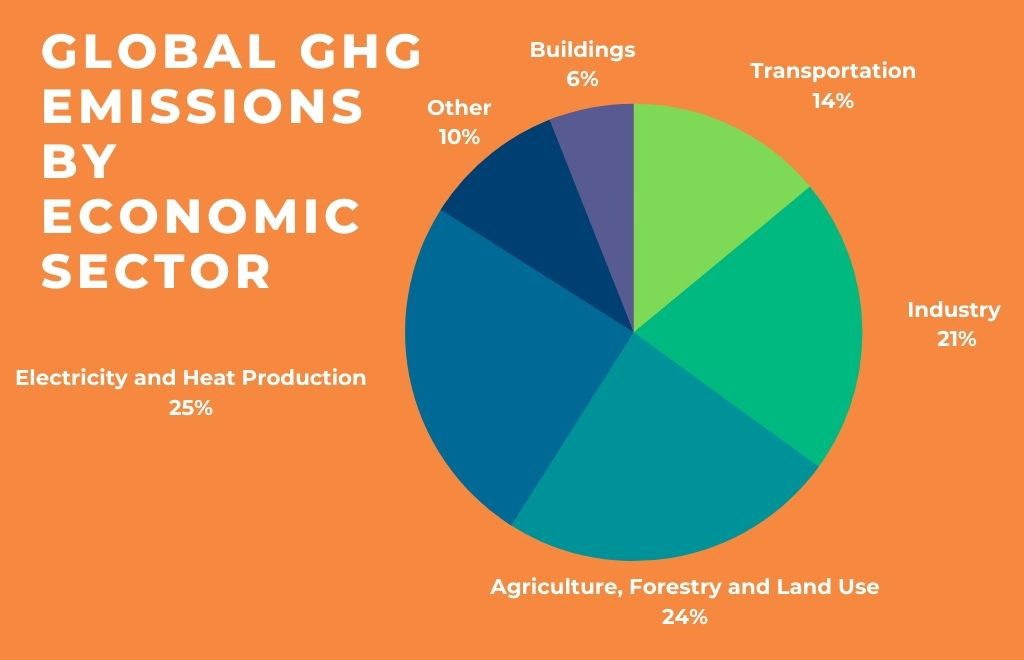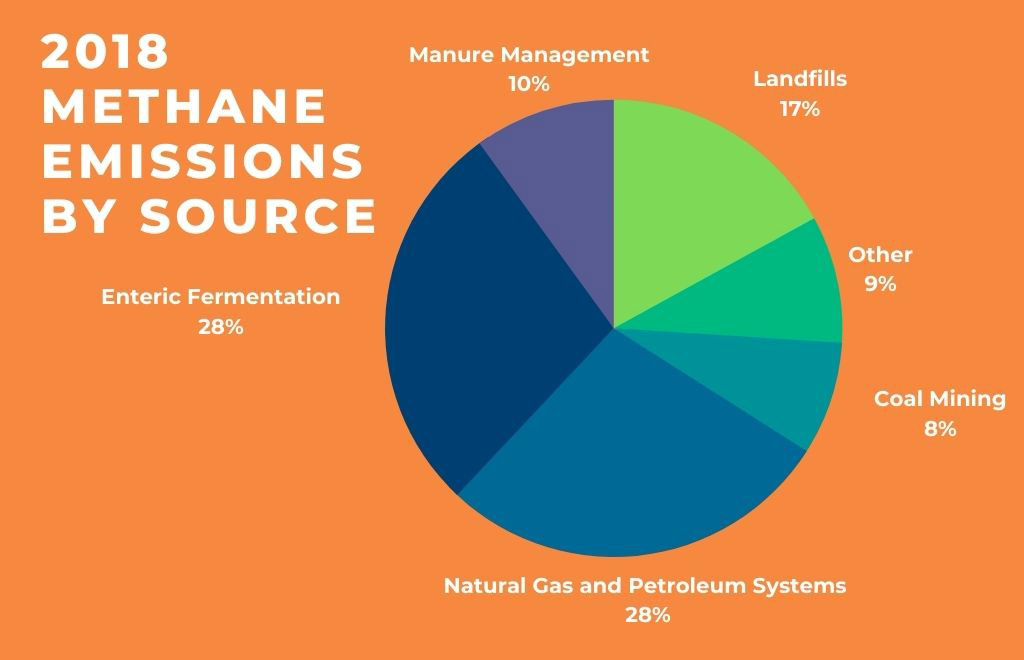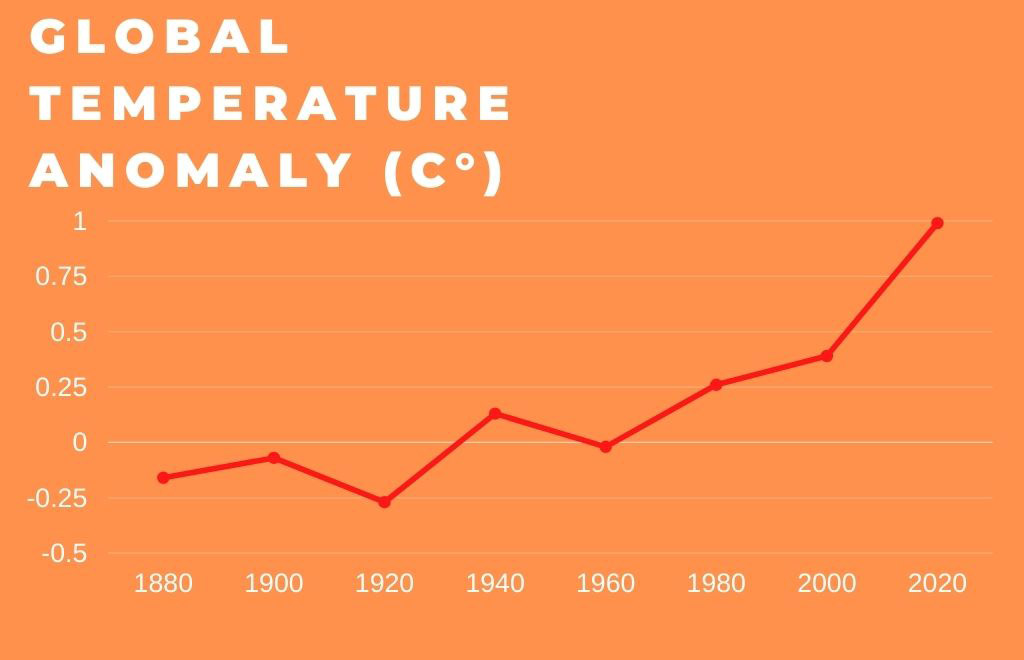The climate crisis we’re living through today is global in scale and global in solution. In order to critically reverse the warming trend that over two centuries of emitting greenhouse gases into Earth’s atmosphere has caused, systemic changes within governments and industry must occur.
In the meantime, the individual choices we make and the “carbon footprint” we create with them, do have the potential to influence culture, drive awareness, and give individuals a small sense of control over a seemingly uncontrollable peril. Reducing one’s carbon footprint allows us to practice what we preach and challenges conventional wisdom that has polluted and heated our home planet.
Adjusting the way we live, work, travel, shop and eat can curb our greenhouse emissions, apply pressure to industry and steer our collective culture toward critical, systemic solutions.
What is a Carbon Footprint Anyway?
A carbon footprint refers to the amount of greenhouse gas emissions produced by the production and consumption of a good or service. Most of our carbon footprints are taken up by transportation, housing and food: getting to and from work, flying for business or pleasure, heating, cooling, and lighting your home, and eating.
The idea of an individual’s carbon footprint was popularized by British Petroleum, the world’s second largest privately owned fossil fuel company. In 2000, BP hired advertising agency Ogilvy & Mather to create the Beyond Petroleum campaign, a PR campaign designed to distinguish BP from its competitors as a progressively minded and environmentally friendly oil company (1).
During this campaign in 2004, BP launched its first carbon footprint calculator, prompting individuals to consider their own responsibility for climate change instead of that of the company producing and selling the lethal products.
The campaign was a success, seizing upon a sense of urgency among the public that something must be done about climate change and that, in the absence of proper organizing or political will, we could take whatever meager matters into our own hands, immediately.
The campaign also worked because, to that same meager degree, it’s true. Taking steps to modify behaviors we’ve become accustomed to and are causing ecological collapse does have a net positive effect, both for the planet and our own psychological wellbeing during this crisis.
A Closer Look at Food’s Carbon Footprint
To reduce your carbon footprint, it’s most helpful to break down your consumption into the three major categories of climate impact: Transportation, housing and food.
As a food company, food is the one that Trifecta works the hardest on (though transportation and housing practices will affect your food’s footprint as well). Trifecta is constantly focused on the sustainability of our food systems. As our supply chain improves, so too will your own carbon footprint.

Food production alone equates to roughly a quarter of greenhouse gas emissions globally (2). This includes growing, farming, transporting, cooking and disposal. Meat, cheese and eggs have the highest carbon footprint. Foods with a low carbon footprint include fruits, vegetables, beans, and nuts.
Raising livestock is among the most environmentally intensive forms of farming.
Nearly half of all global methane emissions come from belching livestock and their manure, making livestock farming a significant contributor to climate change (3). Compounding its impact, livestock requires expansive grazing land which is created with carbon intensive deforestation and slash and burn clearing practices.

9 Ways to Reduce Your Food’s Carbon Footprint
Here are 9 steps you can take today to help reduce GHG emissions.
1. Accept the Science of Climate Change
The first thing one must do to reduce his or her carbon footprint, before any food choices, is accept the settled science that greenhouse gases - carbon dioxide, methane, nitrous oxide, and fluorinated gases - produced by human activity are trapping heat in our atmosphere, which is raising global temperatures.
By acknowledging the crisis, you establish causality and can begin to address which actions in your own life are most impactful.
2. Support Local Farmers
Purchasing local food has many benefits - including supporting local farmers and reducing emissions. Storage and transportation both produce CO2, but luckily both can be cut down with local purchases, since everything is sourced nearby.
On top of cutting down on transportation emissions, food looks and tastes better because it is picked at its peak, instead of before ripeness. It is also more nutrient dense because it arrives on your table faster, leading to less nutrient breakdown.
If these factors don't convince you, then consider the impact you will have on your community directly. When you buy local, you form a strong connection between eater and grower and recirculate your money back into your local economy.
3. Buy Organic
The Food and Agriculture Organization of the United Nations claims that by switching to organic agriculture farmers can reduce up to 66% of CO2 emissions (4).
While organic systems do use less energy, they can also require more land, which can cancel out potential savings in one’s carbon footprint (5).
4. Eat Lower on the Food Chain
Not all calories are created equally. When we think of the food chain, we usually picture bigger animals eating smaller animals, rinse and repeat. In agriculture, it represents something similar. Producing one pound of farm raised salmon, for instance, requires five pounds of forage fish.
In this example, it is far more sustainable, 5x more, to eat the forage fish instead of the farm-raised salmon.
Better yet, go even lower by enjoying low impact, plant based foods instead or intensive ingredients like meat and fish. Avoiding the top links of the food chain is a great way to shrink your carbon footprint without shrinking your waist.
5. Avoid Food Waste
Americans waste approximately 40% of the food we buy (6). That comes out to approximately 218 pounds of food per person (7). Food waste ends up in landfills, where it rots and produces 8% of the world’s greenhouse gasses.
Creating efficiency in your home is the fastest way to improve the carbon intensity of food production. In theory, if we waste less, we will purchase less, therefore reducing demand and ultimately production.
6. Cook Smarter
How we prepare food plays a big role in its post-purchase carbon footprint.
Turning on appliances and cooking produces greenhouse gases through electricity and gas use. Striving to eat fresh foods as much as possible (salads, raw fruits and veggies) and cooking efficiently can reduce greenhouse gases.
When cooking is necessary, the stovetop and microwave are your best options. Try to avoid the oven as much as possible, because it is an energy hog, plus it heats the house up - which may call for your air conditioner (another energy sucker) to work harder to keep the temperature balanced.
7. Meatless Mondays
Love bacon too much to give it up? Keep meat on the menu but try Meatless Mondays. Since not everyone is willing to drop meat out of their diets completely, a great way to make an impact is to eliminate it out of your diet once a week, along with any dairy products.
Although this may not seem like a lot, it can make a large impact if you do it consistently, over a long duration. According to Meatless Monday advocates, like the Environmental Working Group, if your four-person family skips meat and cheese one day a week, it’s like taking your car off the road for five weeks – or reducing everyone’s daily showers by 3 minutes (8).
8. Go Vegan or Vegetarian
Going vegan, by abstaining from all animal products including meat and dairy, could be one of one the most effective ways to personally reduce carbon emissions from food. Going vegetarian is runner-up.
Since meat and fish sit at the top of the food chain and are thought to create the most greenhouse emissions overall, eliminating those out of your diet might reduce your carbon footprint significantly.
Luckily, there are more plant based alternatives to meat than ever before and even the most devoted omnivores should be able to find something they enjoy.
9. Eat Less Packaged and Processed Foods
As renewable sources become more affordable and overtake oil and gas on energy markets, petrochemical companies have pivoted to plastic to keep demand apace. According to a 2018 industry study, plastics are set to be the number one driver of oil demand in the next decade (9).
Packaging accounts for an average of 5% of energy consumption for food products and buying fresh, unpackaged food (and not wasting it), can be an effective way to reduce your carbon footprint (10).
Redirecting Responsibility
Focusing on our own lifestyles and energy use will not alone stem the environmental impacts of the climate crisis, but we can parlay our individual choices into meaningful reforms.
In the absence of political action, one of our only options to demand climate action is to speak with our purchasing power, refusing to support bad actors and rewarding those with environmentally progressive practices.
Additionally, taking an interest in the health of our environment and our responsibility to preserve it is likely to introduce you to other individuals and organizations with similar values. Here we can combine our individual actions into collective ones and build the necessary power to bring about critical change.
Plus, getting active and interacting with others like you is a great way to improve your own mental health and outlook in the face of crisis.
Want to start taking action today? Cut down on food packaging and reduce your footprint with ready-made, plant-based meals delivered straight to your door each week.

